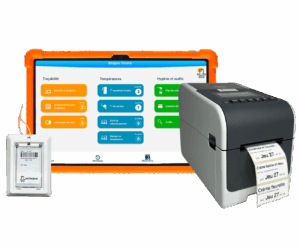Easily create the cleaning plan for your butchery and delicatessen
How to create your cleaning plan in butchery and delicatessen?
Here are all our tips!
The cleaning and disinfection plan is a mandatory document within the framework of the HACCP method. Indeed, microbiological risks are very high in butchery and delicatessen. Maintaining a clean working environment must be a major concern. It is necessary to take great precautions to prevent and reduce the spread of pathogens on meat and delicatessen products. Follow the guide!
HACCP Method – Microbiological risks in butchery and delicatessen
Indeed, several pathogens are highlighted as critical hazards in butchery by the GBPH. This is why cleaning and disinfection are essential. Here is the list of pathogens that a cleaning and disinfection plan helps to eliminate or minimize:
Salmonella:
- Bacteria present in the intestines of many mammals (poultry, cattle, and sheep are healthy carriers)
- Present in egg-based products and dairy products
Staphylococcus:
- Bacteria present in 50% of the population (throat/nose, skin and hair) = healthy carriers
- Cause: Lack of hygiene by the handler
- Develops in various contaminated raw and cooked foods
- Consequence: Production of a heat-resistant toxin
Clostridium:
- Bacteria present in the environment and in insufficiently cooked or slowly cooled foods
- Optimal growth temperature: 45 °C
- Heat-resistant bacteria
Listeria:
- Bacteria present in the environment, found in insufficiently cooked or reheated foods
- Can still multiply at low temperature 3 °C but is killed in 30 minutes at 60 °C
However, cross-contamination between raw poultry meat contaminated with Campylobacter bacteria and other meats represents the main danger in butchery and delicatessen.
To take appropriate measures to eliminate any risk of contamination, it is important to identify contamination points and establish a Cleaning and Disinfection Plan (PND) and follow it.
How to develop a cleaning and disinfection plan in butchery and delicatessen?
The difference between cleaning and disinfection
Cleaning and disinfection are different but complementary operations. Cleaning consists of removing visible dirt using a mechanical treatment (scrubbing) while disinfection consists of eliminating microorganisms after cleaning using disinfectant products.
Cleaning and disinfection require several elements:
- Adequate equipment: brushes, cloths, etc.
- Appropriate products: authorized for food use and having specific properties (virucidal, bactericidal, virucidal).
- A proper method for each element or area of the establishment.
What is a cleaning and disinfection plan?
The Cleaning and Disinfection Plan (PND) is a regulatory concept. According to regulations, it must include:
- The list of hygiene products used: they must be professional-grade, approved, certified food-contact safe, and compliant with NF and EN standards (European and international standards)
- All technical data sheets and safety data sheets for each product used.
- A cleaning schedule for each area specifying the surfaces or equipment to be cleaned, the timing of these tasks, the operating procedure, and the product to be used.
How to clean and disinfect work surfaces?
Before cleaning work surfaces, make sure that all foodstuffs are set aside as they represent a source for germ multiplication. Also ensure the effectiveness of detergent solutions by changing them regularly.
After cleaning operations, it is advisable to disinfect the surfaces to kill microbes. It is essential to strictly respect the product’s contact time. Since cleaning/disinfection products can contaminate food, a thorough rinse with clear water must be done afterwards. These products must never come into contact with food.
Finally, cloths should be soaked in a disinfectant solution after thorough rinsing or washed in a washing machine at 90°C. Let them dry completely. For example:
| Frequency | Method | |
| Cleaning – Detergent solution |
|
|
| Disinfection – Disinfectant product |
| After cleaning
|
Cleaning and disinfection of machines and utensils
Regarding utensils (knives, spoons, etc.) and removable parts of machines, any presence of organic residue hinders the effectiveness of cleaning/disinfection products.
Thus, it is advised to:
- remove all food residues before cleaning operations
- change the washing water as soon as it gets dirty. Indeed, water containing food residues turns into a breeding ground for microorganisms in a few hours
- always rinse with hot running water
| Method | |
| Pre-washing – Immediately after use |
|
| Cleaning and disinfection – After every use |
Or
|
Cleaning and disinfection of the laboratory
In butchery and delicatessen, the laboratory corresponds to the product preparation area. It includes several high-risk work zones that must be thoroughly cleaned and monitored to preserve product quality and safety.
Among these zones:
- Receiving and unpacking area
- Dry goods storage area
- Cold storage area for meats, carcasses, etc.
- Hot storage area for cooking and weighing
- Finished product storage area
Microbiological control plan for the butchery cleaning plan
Given the multiple pathogens responsible for food poisoning present in butchery and delicatessen, regulations require professionals to implement a microbiological control plan with the help of an accredited laboratory (EC Regulation No. 852/2004).
This laboratory can conduct analyses on products and surfaces and estimate risks based on levels of dangerous pathogens that must not be exceeded as determined by European regulations (EC Regulation No. 2073/2005).
The results reflect hygiene conditions at various stages of production and storage (receiving, processing, preparation, storage). This allows you to evaluate hygiene compliance and detect possible production anomalies. It also helps to improve work organization and cleanliness in a way adapted to detected microorganisms.
Shelf-life tests in butchery and delicatessen
Shelf-life tests validate product shelf life in butchery and delicatessen. Recommendations on conducting shelf-life tests are provided by the standard NF V01-003.
They are systematically requested by control services. However, these tests are expensive and not mandatory. Initially, you can validate product shelf life with microbiological analyses.
To do this, when the laboratory visits, you can provide end-of-life products. The shelf life will depend on microbiological results. If satisfactory, the expiration date is validated.
Use of water in butchery and delicatessen
According to the GBPH and to create the butchery cleaning plan, water is also identified as a source of hazard. Indeed, water used as an ingredient and that can come into contact with food must meet minimum requirements set by articles R 1321-1 and following of the Public Health Code (which transpose Directive 98/83/EC of 3 November 1998 on the quality of water intended for human consumption).
It must not contain microorganism concentrations or any other substances that could pose a potential health risk.
It is also necessary to ensure a supply of potable water at appropriate pressure and temperature. However, non-potable water should only be used for operations unrelated to food.
Do I need to have my water tested?
It is important to know that water analyses are performed by your municipality and are available online. These are often requested by control services.
However, the food sector operator is responsible for water quality from the connection point to the point of use. They must therefore establish a monitoring program including:
• Sufficient control of the quality of supplied water.
• Regular inspection of installations, especially the internal water distribution network and any treatment devices implemented.
• A program of tests or analyses carried out at points determined according to identified hazards that installations may present. These hazards may be due to infiltration or the development of specific microbial populations in pipes: biofilm.
• Keeping a sanitary file collecting all information gathered.
Waste disposal
Finally, it is necessary to provide an effective waste management system (collection and disposal especially). Organic waste must be collected separately from other waste (with identified bins and equipment, e.g., different colors). The workflow must respect the forward flow principle as well as prevent any cross-contamination with raw materials.
Waste storage must be done in closed bins in a locked room to prevent pests access and avoid contamination of food, equipment, premises, and personnel.
Regarding waste bins in the production area, they must undergo cleaning and disinfection before each emptying.
It is important to specify the frequency and method of waste disposal. This should be at least daily for non-organic waste and every half-day for organic waste.
Download our special butchery cleaning plan guide
You will be able to build your cleaning plan with our free tables. Choose the areas, the elements, and create a coherent plan.



